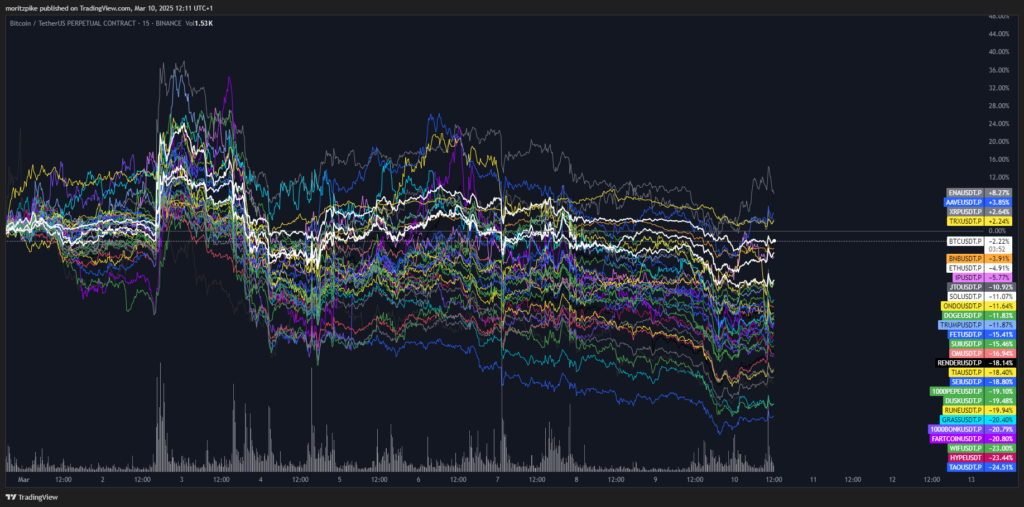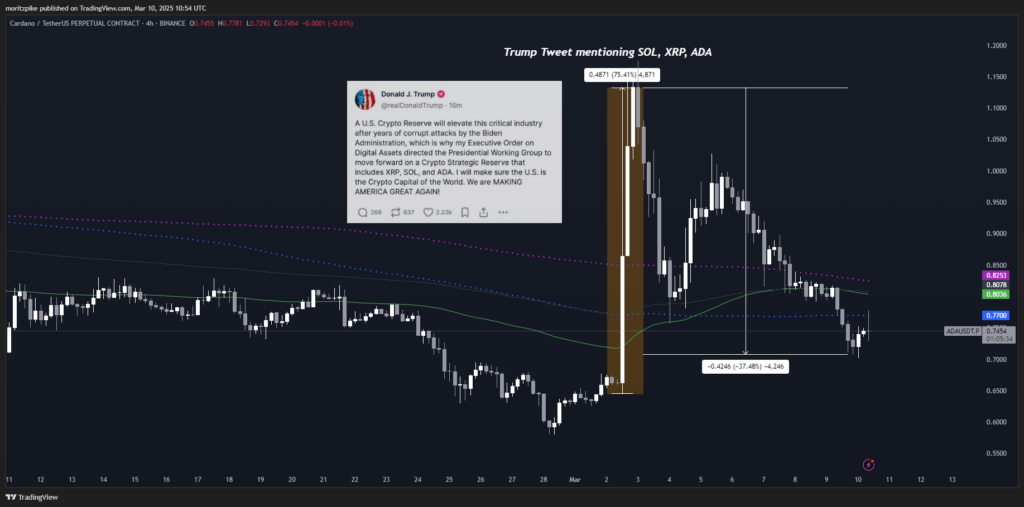As we enter a challenging phase for crypto markets, with Bitcoin trading nearly 30% below its all-time high and many altcoins completely erasing their recent gains, investors find themselves searching for direction. The current market environment lacks compelling short-term narratives that typically fuel upward momentum. This uncertainty is compounded by weakness in traditional equity markets, which are grappling with escalating tensions from the advancing trade wars and shifting macroeconomic conditions. This edition highlights key developments worth watching and offers insights to help navigate these uncertain waters.

The Trump Administration’s Crypto Stance: Reality Check
While Crypto Czar David Sacks champions the message “Promises made, Promises kept,” the reality appears more nuanced than initial market optimism suggested. The administration’s approach emerges as primarily Bitcoin-centric, positioning BTC as digital gold with plans for a “digital Fort Knox”—a significant institutional validation that could be implemented via Executive Order similar to the original Fort Knox.
However, the broader crypto ecosystem may find less to celebrate. Despite earlier excitement fueled by Trump’s tweets mentioning ADA, SOL, and XRP (amplified by his own family members), Sacks himself downplayed these mentions as merely referencing “Top 5 cryptocurrencies” without special significance. The administration appears focused on preventing prosecution and debanking of crypto businesses—certainly an improvement over the previous regulatory environment—but falls short of creating the comprehensive “crypto capital” vision many had anticipated; more likely they are just paying some donors back with their support.

For market participants, this recalibration is crucial: the current regulatory direction represents a significant positive shift from the hostile stance of the previous administration. But there is still an Elephant in the Room right now:
While Sacks claims that Trump’s mention of ADA, SOL, and XRP was merely due to their position among the “Top 5 cryptocurrencies by market capitalization,” this explanation leaves important questions unanswered. Critics point out that both BNB and DOGE are also among the top cryptocurrencies, yet they received no mention in Trump’s widely-discussed tweet.
This selective communication fuels speculation about potential conflicts of interest within the administration or connections to campaign donors. Particularly against the backdrop of Trump family members actively amplifying these tweets, the impression of a coordinated market intervention emerges. The central question for market participants remains: To what extent are the administration’s political decisions and public communications influenced by personal financial interests or obligations to supporters?
For the rational trader, this means exercising particular caution when interpreting political signals and factoring in the possibility that certain assets could be deliberately influenced through coordinated communication. Remember: It’s crime season.
The $HYPE Dilemma
Hyperliquid stands as one of this cycle’s most promising projects—a decentralized exchange boasting impressive trading volume, strong revenue, an active user base, and token buyback mechanisms. Yet its native token $HYPE now finds itself at a critical juncture that perfectly encapsulates the current market sentiment.
The platform made headlines by creating overnight wealth for many through its generous airdrop, transforming users into dedicated “bagholders.” However, beneath this success story lies a troubling reality: the “Traders Net PNL” curve continues its relentless downward trajectory. Many traders have likely faced liquidation, and now view $HYPE as potential collateral to free up margin for their elusive “comeback trade.”

This creates a fascinating market dynamic. At $4.8 billion market cap ($14.3 billion fully diluted valuation), $HYPE appears increasingly attractive given the project’s robust revenue streams. Add to this the phenomenon of forced selling—often described as “forced selling is often a free buy”—and contrarian investors might sense opportunity.
Yet caution is warranted. The selling pressure shows no clear signs of abating, especially as the broader crypto market struggles to identify compelling narratives that could drive significant upside. Without a fresh catalyst, even fundamentally sound projects like Hyperliquid may continue to face downward pressure as market participants recalibrate expectations in this post-100k Bitcoin environment.
For traders navigating this landscape, the $HYPE situation represents the broader dilemma: identifying the delicate balance between value and momentum in a market where forced liquidations create potential entry points, but where each bounce remains vulnerable to further drawdowns until a new macro narrative emerges.
Psychological Check: Bag-Holding Decision Framework
@CryptoCred offers a ruthlessly practical framework for traders caught in the recent downturn:
This clear-eyed assessment cuts through emotional decision-making and provides a valuable thought exercise for portfolio reassessment in challenging market conditions.
Navigating the Narrative Vacuum
The current market correction highlights a fundamental truth in crypto: fundamentals matter, but narratives drive price action. As we’ve seen with Bitcoin’s retreat from $100k, Hyperliquid’s impressive revenue versus its declining token, and the complex political dynamics at play, this environment demands both patience and strategic positioning.
The most successful traders will be those who can distinguish between temporary sentiment shifts and genuine value opportunities—while maintaining the psychological discipline to cut losses when necessary and preserve capital for the inevitable next wave of momentum. Until a compelling new narrative emerges, expect continued volatility and selective opportunities rather than broad-based recovery.

Leave a Reply